September 22nd, 2010 · 1 Comment
As I and many others have mentioned in previous posts, examining religion and religious life in London has been a big part of our course. Central to increasing our knowledge and understanding of a number of religions has been visiting the various houses of worship. We have visited a few churches, a mosque, a mandir, and a synagogue. We have gone into these institutions with varying levels of welcome, and we have observed a variety of rituals, customs, and traditions.
Beauty has also been a recurring theme in the course. Almost all of the houses of worship that we visited had put serious thought and effort into the beautification of their buildings. The only exception was the mosque, but I think it is ok to assume that this was due to the financial circumstances of the community than lack of desire or appreciation for a beautiful space. In addition to all being beautiful, these spaces were all aesthetically very unique. The Mandir was extremely ornate, but not to the point of tackiness or fussiness. All of the stone and teak carvings were well executed and the building as a whole had a feel of luxury to it. The synagogue was a more simple, paired down building, but even as a more streamlined space, it still packed ample visual drama in the floor to ceiling red and gold mosaic behind the ark and tall, dramatic stained glass windows, which unfortunately had to be obscured by anti-terrorism curtains.
Comparing St. Paul’s and Westminster Abbey, aesthetically, St. Paul’s is the clear winner. Westminster Abbey is cluttered with tombs and plaques and statues, it is mostly dark and parts do look kind of shabby. Don’t get me wrong, it’s a place of great historical significance and cultural value, I’m not denying that, but on looks alone…. ehhh. St. Paul’s on the other hand, is light, airy, and spacious. It has a regal, elegant exterior and strikes a nice profile. The mosaics on the ceiling close to the WWII memorial were exceptional. As John explained to us, the tesserae had been set in at a specific angle, not flat against the wall, so that the sunlight reflects off of them just enough to allow them to glint and glitter. Perhaps over stepping here, but I think the visual atmosphere, the aesthetics of the particular houses of worship, reflect something of the character of the congregations who pray there.
Tags: 2010 Rachel · Uncategorized
September 21st, 2010 · 1 Comment
Throughout the entire month in London, people have moaned that the churches/cathedrals we went to were lacking: there was no spiritual awareness, that it was too touristy, etc. While this is true to some extent, I felt that we went as tourists, not inquirers, like we did when we visited the synagogue, mandir, and the mosque. We weren’t going to a local parish where they were as keen to brag about what went on there or where they felt it was strictly necessary to outline more of Christian theology.
Yesterday I ventured over to St. Bartholomew the Great, just a few blocks away from the Museum of London. It’s the oldest active medieval parish church in London, so naturally I had to see it. (Bonus Fact: Parts of Shakespeare in Love were also filmed there.) I wasn’t sure what to expect as I was walking up to it; the church was set off from the main road. The gate you have to go through is where Richard II stood when he met with the leaders of the Peasant’s Revolt. Upon entering the church and paying my meager entrance fee (3 pounds), I was asked where I was from (Apparently the smiling gives it away if the accent doesn’t…) and handed a guide of the can’t miss bits.
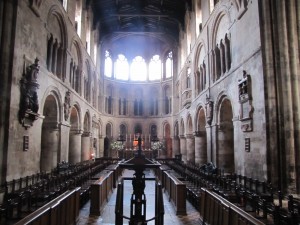
As I walked through, I got a since that this was what Westminster Abbey would look like if it hadn’t been messed with and wasn’t always undergoing some form of renovation. I passed the medieval baptism font (where interestingly enough, Hogarth was baptized). There was modern art throughout that the church had commissioned to take the place of older pieces and to go over empty spots on the wall. I was somewhat annoyed by this, but I felt that it added a living dimension to the church: it’s still shaping its image, showing its continued importance.
Sounds a bit like Westminster Abbey with famous bits so far. Well, it was, but considerably less magnificent.
Then, I stumbled upon the video that told the church’s history. Think the history lecture we got at the synagogue but extended to include how the church is still active in the parish. (On my way out I noticed there were pamphlets on what to do if you wanted to get married there, join the church, or have a christening.) The video addressed almost every issue, especially how the church is still relevant today, that people had raised.
Even better, there was a chapel that reserved for people who wanted to pray. It was out of the prying eye of the tourists (all five) who were ambling through the church. (The entry fee was waved if you were there to pray.)
By the end of my visit, I had felt that I had an experience more akin to those at the other places we visited. If I had had a lay guide I am positive that I would’ve felt that I were there as a visitor rather than a tourist.
Tags: 2010 Stephenie · Churches and Cathedrals
September 21st, 2010 · No Comments
We have been to our fair share of churches, cathedrals, and other religious buidings. Looking up at the incredible painted ceilings and windows at these cathedrals, a visiting American would typically think, “My church doesn’t look like this”. The churches of London have been constructed by world famous architects for hundreds of years. The role of churches in London differs vastly from the purpose of churches in the United States (this we have discussed several times). The main purpose of these churches is rooted moreso in the Brits deep pride and value in their rich history a bit moreso than the prayers and sermons that are uttered in the buildings.

Westminster Abbey
Since my time spent here I have noticed that the Brits care a lot about, and ruthlessly display their long, inspiring history. I believe that these churches (St. Pauls, Westminster Abbey, etc.) serve as living pieces of history for the Brits moreso than places of worship for that reason. Walking through Westminster Abbey almost seems like your at some sort of Rock N’ Roll hall of fame for famous people’s graves. I can’t think of a better way of preserving and glorifying history than walking through a museum of dead guys with significant roles in the history of London. The elegant layouts and statues where the heroes of London stand frozen in time give places like the Abbey almost a museum-type feeling. I especially felt this way on our tours in the Abbey and St. James, where I felt like we were being ushered from exhibit to exhibit. The basement of St. Paul’s was even undergoing work so that they could put an exhibition on display, not unlike a museum.

St. Paul's Cathedral
Of course, these churches do still hold religious ceremonies; I saw a wedding at St. Pauls one of the days we went there, and there was a moment of silent prayer when we were touring Westminster Abbey. Our tour guides explained at several of the sites about how their regular services proceed as well. These religious observations still seem to be playing second fiddle to the awesome, breathtaking history that the churches hold. I am sure that more people attend tours than services on a daily basis at a place like St. Pauls or Westminster Abbey. Along with the Brits’ pride and dedication to their history, these churches serve as spots that honor the unification of London and its people as a whole. Hell, the entire country had a national religion in the Church of England for many, many years. One country, the majority of which were a member of one religion, and the church for which all these buildings were constructed. Our tour guide at St. Pauls explained how during the Blitz, a chaotic period that made the people of London fear for their lives on a day to day basis, that as long as they could see St. Paul’s church everything would be alright. Quite a deep belief on the part of the people of London. A belief reinforced by their nature of being proud of their past and their knowledge of it. So, while these churches and cathedrals might appear to be some kind of religious museum, they remain some of the most well recognized and inspiring aspects of London.
Photos courtesy of: members.virtualtourist.com, lilacnet.net
Tags: 2010 Benjamin
September 21st, 2010 · No Comments
I’ve really enjoyed the religion component to this course. Although I don’t believe in organized religion, I’ve never dismissed knowledge about other religious customs and beliefs. However, when visiting famous sites like The Westminster Abbey and St. Paul’s Cathedral, which do attract large masses of tourists, I felt as if I was in a museum rather than a place of worship. Westminster Abbey did have the occasional moments of silence for visitors to remember that it was a religious establishment, however I still didn’t really feel the connection. While I do understand that of course, these beautifully crafted structures are world renowned, if I was religious I would feel a little uncomfortable with a church being more of an attraction than anything else. Visiting St. Paul’s and Westminster did not provide me with any religious education however, when I visited Bath Abbey they did hand out pamphlets that highlighted the importance of God in our lives and bible scriptures, which I appreciated and thought that the other establishments could have done the same.
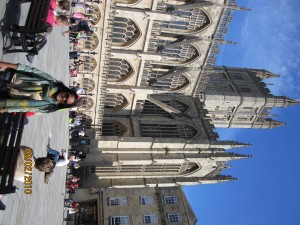
My favorite visits were to the Hindu mandir and the Islamic mosque because I really gained valuable knowledge. Although the mandir also seemed like a tourist attraction, in addition to showing off the intricate details of their temple, they also made efforts to teach the public about their beliefs with providing the exhibition on Hinduism. The mosque wasn’t touristy, but our guide was helpful in explaining his religion and did his best to make connections between what we already knew and contrasted his views to some of our own religions. What I enjoyed hearing about the most was how involved these establishments were in their communities. I think it is great that they participate with people of other faith to reach out and service the community. The mosque’s involvement in TELCO (The East London Communities Organization), which has a commitment to “working together for common good and changing the way politics happen in London”, was one of the many ways that they contributed to their neighborhood.
I found the guide of the mosque to be the most interesting out of all of our visits because he shared something that I have never a representative of any religion say; he admitted that his people suffered from a lack of knowledge about other people’s faith. He shared that there are some people who think they know all there is to know and don’t seek additional knowledge and in his opinion this contributes greatly to the barrier between the Islamic people and the rest of the world. His honesty was admirable and I strongly agreed with him. Something as small as seeking basic understanding of other peoples and religions really can go as far as changing the world one day.
Tags: 2010 Melissa
September 20th, 2010 · 2 Comments
Most of you have been writing about the secular nature of churches in England, how they don’t really seem like a spiritual community, and how it is a bit disturbing that all of them come with cafes and gift shops. While I agree with these thoughts, I don’t think that it is necessarily all bad, and I think that we need to consider that we are not seeing the entire picture.
I think that the secularism of the Anglican Church particularly stands out against our visits to the Mandir and the mosque. At these places of worship, people go to pray every day and there are spiritual ceremonies every day as well. They each have schools, child care centers, and service projects that reach out to the community. I can see where we might wonder why we are not seeing the Anglican Church step up to its role as a spiritual and community leader, but remember that we discussed in our first ever class meeting how in these minority communities, religion is very much one and the same with culture, especially in Islam. The difficulties they have assimilating into English culture are due in large part to religion. Religious teachings and traditions have become well ingrained cultural traditions. Anglicanism is a relatively new religion in comparison with Hindu and Islam, and does not play the role of being one and the same with culture like it does in the other communities. And when you are the majority community racially, religiously, politically etc…it doesn’t need to be.

the Mandir, courtesy of it’s website mandir.org
The second point I wanted to make in this post is that Westminster Abbey and St. Paul’s do remember their function as places of worship. I was on the Westminster Abbey tour with the science group. We were there at noon, and at that time an announcement came on that called for a moment of silence. John reminded us that we were in a church, not a museum, and I noticed that nearly everyone visiting the Abbey at that time, tourists included, was respectful of this moment. I also attended Evensong at St. Paul’s and thought that it was a beautiful and moving experience. I think that they balance their two roles as best as they can, and hey, if my church had a café, I would use it. Speaking of places of worship that balance spirituality and tourism, look at Vatican City. No one can argue that this is not a deeply meaningful and spiritual place; Catholics journey from miles around to hear the Pope speak on Christmas, or at any other time of the year really, but it is also a huge attraction, complete with guided tours through St. Peters and rampant pick pocketing.
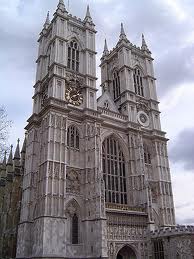
photo credit: Google Images

photo credit: Google Images. All of these buildings were too big and beautiful for me to take a good picture of them myself.
Finally, the fact remains that we have not been to any small Anglican parishes in specific residential neighborhoods of London. I’m sure that there are religious Anglicans in London who do go to church every Sunday and whose churches run community service projects and functions, but, similar to your local church at home, which also attracts no visitors, these churches probably don’t have history such as the Battle of Hastings and the Great Fire of London surrounding them. We definitely are not seeing the whole picture here, which is why I cannot join in lamenting and expressing disappointment in places like Westminster Abbey or St. Paul’s, or the Anglican Church in general.
Tags: 2010 Kaitlin
September 19th, 2010 · No Comments
One of the things that has truly surprised me during our time in London and in our readings over the summer was the lack of a widespread religious sentiment and a growing secular way of thinking. Visiting the different places of worship for me has been very enriching. I sincerely enjoyed hearing about the way different roles of various institutions in their communities. Despite this growing secular sentiment, it was evident to me that faith is still an important key to Englishness. Sure, we may not have had the same treatment at the Christian institutions we visited, but we weren’t at the parish church where they would have stressed the other parts of Christianity outside of the famous dead people.
At the mandir, mosque, and synagogue, I did learn something about other faith communities, all of which I wasn’t that familiar with. Familiar with Christian outreach, it was interesting to hear the way other faiths volunteer and conduct outreach. I was also intrigued by the amount of history each guide mentioned; at the mandir, there was a specific exhibit to help you understand the history and beliefs of Hinduism. At the mosque, the guide spent more time on the basic principles, whereas at the synagogue it was much more history heavy, which I enjoyed (despite the slight mix up with who declared the crusades and who ordered Richard’s). Yet, they all stressed the importance of the community and what they did for the community. At the end of each tour, I felt that I had been where a faith was active and thriving- counteracting the general arguments we had encountered.
Before I talk about my favorite experience, I’m going to go off on a bit of rant/tangent. (Nothing unusual, you’re probably thinking.) While Christianity is undeniably not as much on the forefront as it once was (I sometimes forget I’m not in the Middle Ages where the church was as influential as those in political power and grotesques littered the cathedral for unknown reasons), it is still playing an important role in England. How? Most noticeably, the concerts we’ve attended. Sure, they haven’t been lectures in Christianity, but they have brought people into a church where they were witnessing a faith community. You don’t necessarily have to have a lecture about the religion’s history when you are there in order to spark an interest. Sometimes a few trips for concerts or to be a tourist will spark an interest and prompt someone to ask a question that leads to a serious discussion. Yes, it would have been nice to have left any of the churches/cathedrals with a pamphlet on basic Christianity, but because those audiences (presumably) weren’t there to learn about Christianity, a pamphlet may have been more alienating than encouraging.
Okay, so my favorite experience and what it taught me. Hands down, my favorite has been (no surprises) Westminster Abbey. (This may change as I’m hoping to get over to St. Bartholomew the Great tomorrow; it’s a medieval parish church.) Why when it didn’t actually teach me about Christianity or the abbey that I didn’t know? One, because it inspired my faith through the sweeping architecture and stained glass. For me, those are more impressive and awe-inspiring than St. Paul’s (in its present Wren-wrecked – okay, so maybe that’s a bit harsh-state) could ever dare to be. Two, because as a medievalist, I was able to participate in a long-standing tradition: the pilgrimage. Throughout history, people have visited sites throughout the world for many reasons. At Westminster Abbey, everything I love was combined into one place: my faith, grotesques, cosmati, saints, Chaucer, Gothic architecture, etc. I was on a pilgrimage of sorts. True I wasn’t there to pay my respects to Edward per se, but I can’t deny seeing the tomb of such an important figure didn’t give me chills (even though it’s been really messed up and reassembled incorrectly). I didn’t necessarily have to learn anything about Christianity to have an incredible experience. Yet, to say I didn’t learn anything is mistaken. I did, but I learned more about the position of the Church of England. It is clearly in decline, but the abbey is doing what it can given its monumental dual-purpose (protect priceless art and architecture while spreading its Christian message).
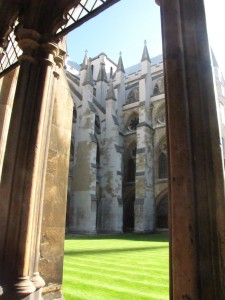
I’m sure some of us would argue that it is up to these major institutions to take the lead in revitalizing Anglicanism, and to some extent Christianity, in England. However, because Westminster Abbey stands for so much more than just Christianity (whether this is a good or bad thing is up for debate), it is important for some of the parish churches to be more vocal on these issues. For Westminster Abbey (and to some extent St. Paul’s) to take a major stand is a conflict of interests, a problem that lays at the heart of its problems rises: should it risk alienating the audience that helps it survive in order to promote its beliefs? It shouldn’t compromise its faith (and I don’t think it does; it does remain closed for services on Sundays as well as hosts small prayers and services throughout the day/week) in order to protect its architecture, nor should it compromise its architecture to protect its faith. They go hand-in-hand in many regards. Without either, you lose part of the abbey. If there was ever a lose-lose, impossible to win situation, double-edged sword, etc, this was it!
I’m hoping as I visit other major medieval cathedrals, a solution to the Christianity vs. tourism problem will become evident, but for now Westminster Abbey will have to be simply (as its Cloister represented for its medieval monks) my paradise on earth.
Tags: 2010 Stephenie · Churches and Cathedrals
September 15th, 2009 · No Comments
-
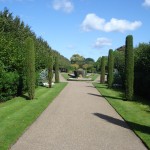
-
Regents Park
-
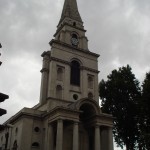
-
Christ’s Church
-
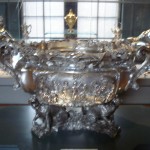
-
The Silver Exhibit in the V&A
-

-
Having a Good Time at the Fitzroy
Like many of my classmates I decided it would be worthwhile to summarize all of my discoveries this month in London. During this post I will focus on six main themes found within London: Parks, Churches, Pubs, Other Religious Institutions, Theatre and Museums.
Parks
Each park that I visited had its own distinct characteristics that separated it from any other. Green Park was the first I visited and after perusing a few others, I realized there was nothing that exciting about it. Located right across from Buckingham Palace, Green Park certainly provides a good place to go and take a break from the busy atmosphere of the area. Besides this however there is not much going on and I would recommend that potential park goers walk the extra distance over to St. James Park.
In addition to the large number of waterfowl heckling people for food which offers consistent entertainment St. James offers some picturesque flower beds throughout and various monuments along the way. It has the relaxing atmosphere of Green Park with a bit more excitement sprinkled in.
Regents Park offers a completely different feel from Green or St. James. Located in a separate area of London, Regents Park has a history of being used by a higher end crowd. I could tell this immediately from the feel of the park. The decorative shrubbery and elegant architecture throughout gave me a feeling that Regents is not as well used as other parks.
Since I was one of the members of the Parks group that gave a walking tour of Hyde Park and Kensington Gardens I could go into a lot more detail about these two green spaces but I will choose not to in an effort to be concise. In summary Hyde Park is the largest green space in London and is often used for larger events such as concerts, festivals etc. It also contains a large number of monuments throughout including the 7/7 memorial and the Diana Memorial Fountain. Kensington Gardens is home to a variety of key monuments but is not as well trodden as Hyde. Overall it makes for a quieter atmosphere, more conducive fo reading or “snogging”.
Regents Park were my two favorite green spaces in London. Regents, is both beautiful, and extremely large and I continually felt the need to go back and explore. Kensington Gardens appealed to me in that it was quainter than Hyde Park but contained a like amount of history and monuments throughout. Although I would be content spending a length of time in any London green space Regents and Kensington would be my top choices.
Theatre
Overall I enjoyed going to the theatre on so many occasions. What better place to do so than in London after all? Here I will discuss my favorite performances and theatre venues.
All in all I enjoyed all but two of the performances we saw. The two Shakespeare productions at The Globe Theatre were fantastic. Although I did not particularly enjoy reading Troilus and Cressida it made a huge difference to be there so close to the actors. The fantastic drum chorus at the end really sealed the deal. As You Like It was probably my favorite show I saw here in London. Although it is one of Shakespeare’s simpler plays the actors really made it jump off the page. Being down it the pit was fantastic because of all the ad-libbing and constant interaction with the crowd. I even felt traces of Touchstone’s saliva on my arm at one point.
The other Shakespeare performance I saw, All’s Well That Ends Well, was lackluster. Although the Olivier was my favorite performing venue (this is what an auditorium style theatre should be like…why can’t Dickinson have something like this?) the play itself was odd and ended on an abrupt and odd note.
The other play we saw at the National Theatre, The Pitmen Painters, was fantastic. Although I was dozing a bit because of the Benadryl I took right before the show, the actors kept my attention and I appreciated that the play was based off of a true story.
Easily the oddest play we saw was Arcadia. An extremely intelligent performance the play juxtaposed two different periods in time and created a singular storyline in which the plot was based. Overall it was an entertaining performance that made me think early and often.
Finally there was Blood Brothers. The lone musical I saw produced feelings of disbelief, anguish and held back laughter. The ridiculous 80’s sound track and creepy narrator just didn’t do it for me. I think it’s safe to say that I was not the only one from Humanities 309 who was a bit surprised to see just about everyone in the audience give it a standing ovation.
I had a very positive experience with the theatre here. I would go back to the globe again and again. I loved being that close to the action. I would also enjoy seeing another show in the Olivier. There really is so much to choose from here. It’s simply a matter of figuring out your tastes and saving your money so you can see a lot of performances.
Churches
From Westminster Abbey to St. Paul’s Cathedral we saw most of the major churches/cathedrals during our month in London. St. Paul’s was easily my favorite. From the fantastic crypt to the hundreds of stairs up to the tower it had so much to offer in the way of history and mystique. Westminster Abbey fascinated me primarily because of all the literary figures that had been buried inside as well as the room that was dedicated to “The Order of the Bath”. Other churches that I really enjoyed taking a look at were: “St. Martin in the Fields” which sits just outside Trafalgar Square and Nicholas Hawkesmoore’s “Christ’s Church” which is located in very close proximity to Brick Lane.
Other Religious Institutions
Overall the Sikh Gurdwara was my favorite place that we visited. I appreciated the simplicity of the religious doctrine as well as the conviction and honesty with which our tour guide, Mr. Singh spoke. The morning was capped off with a fantastic sit down meal together in which everyone was served the same food and drink.
I had different feelings about the Hindu Mandir. It was clear to me from the very beginning that the Hindu religion is not nearly as modest as Sikhism nor are they trying to be. From the extremely decorative prayer room, to the museum located right in the center of the Mandir I never felt particularly comfortable inside.
The only religious institution I wish we had gotten a chance to visit is a Mosque. I had been to one many years ago but I did not remember a whole lot from my experience. I wonder how much more lively the East End, and all parts of London would be if Ramadan were not taking place during our time here.
Museums
I could go on and on about museums so I will attempt to stay as concise as possible.
The British Museum was massive, convenient since it was so close to the Arran House but a little one dimensional at times. One of my favorite exhibits at the British Museum was a special exhibit on Living and Dying that drew information from all different time periods and cultures.
The National Gallery was fantastic. Although I have a hard time appreciating some visual art the gallery kept my attention for a number of hours. Seeing so many famous works of art was phenomenal.
The Tate Modern was my least favorite museum here. Although I am trying I have a hard time understanding modern art. After about 45 minutes in this museum it ended up being too much for me.
The Cabinet War Rooms/Churchill Museum were two of my favorites. The realization that I was standing in one of the most important places in World War II history was unbelievable. The War Rooms felt so authentic. I really felt as though I had been taken back in time to the 1940’s while inside.
The Victoria and Albert was easily my favorite museum in London. There was so much variety inside and so much to see. I could have easily spent a few days inside. Two of my favorite exhibits were the silver and jewelry exhibits. I’m not sure what this says about me as a person but I found it unbelievable that individuals could even own such treasures. I also enjoyed the laid back atmosphere of the V&A staff. At most of the other museums I visited I felt like I was doing them a disservice simply by being there. Although I understand that taking pictures of an object in a museum doesn’t do it justice I like to be able to have the option of doing so.
The Sir John Soane museum interested me but it wasn’t really my cup of tea in the end. It also had a stuffy atmosphere to it that I didn’t really appreciate.
One thing I can draw from my experience at museums here is that each and every one has something that distinguishes it. With so many museums I thought that it would be impossible to avoid some overlap but I never really felt that. Cheers to London and its museums.
Pubs
Finally we have pubs. What would London be without it’s public houses? In some cases pubs are the true museums of London, designating what an area was like in the past and what type of clientele it attracted. During my month here I had a chance to visit a few pubs and get a general sense of what some possible differences could be. It is clear to me that each pub brings something different and unique to the table. The Marlborough Arms was convenient being so close to the Arran House and was a great place to enjoy a pint over a meal with friends. The Court was conducive to socializing in a different way. The music was louder, the people louder and the drinks cheaper. Other places I visited offered other things that made them stand out as well. One thing that i’ve learned about pubs is that it’s hard for one to please everyone. Since everyone has different tastes and desires when it comes to pubs you are better off going to one with a small cohesive group.
To conclude this novel I would just like to say that I think we saw a lot of different faces of London this month. I realize there is much more to see here but between walking tours throughout the city, trips to major monuments and museums and individual exploration I have learned a ton about London, it’s history and where it is going. I look forward to more London explorations in the future but for now, ON TO NORWICH!
Tags: Churches and Cathedrals · Henry · Pubs · Theatre
Tourist-a person who travels for pleasure or culture, usually sightseeing and staying in hotels (Webster Dictionary).
Tourism. I am a tourist. A tourist in England, specifically in London.
For the past two weeks it has been an interesting feeling to be identified as a tourist, especially because I have never had an experience or ever held a title of “a tourist.” And upon arriving to London and feeling comfortable in this big city, I felt like I was exploring a borough in New York City. Tourism. Although throughout time people like to shed the idea and a title of being a TOURIST I, on the contrary, have been acknowledging and embracing my expedition. Let me explain…
My journey towards loving being a tourist began upon our entrance to the Westminster Abbey. The fact that I felt like a tourist might have been due to all of the other tourists surrounding me, gazing at all of the famous philosophers, artists, writers, politicians laying in their tombs beneath our feet. This visit has definitely imprinted itself in my mind. When again will I be able to stand close to Isaac Newton, Charles Dickens, T.S. Eliot, Elizabeth I, Charles Darwin and many others who have had made such amazing impacts on OUR civilization and MY world today. I wonder what other “tourists” felt when they were taking each step across the tombs. Whether they have realized how much history existed in one structure.
Tourism. I am exploring another culture, visiting exhibitions, museums and parks that are only accessible to me on this visit to London. I am amazed.
Visiting the National Gallery was another experience where my temptation to touch the art work of Leonardo Da Vinci, Claude Monet and Van Gogh reminded me of my “touristy” ways. As I stood close to pieces of never repeated art I was staring my privilege right into the eyes . I am one of the lucky ones who gets to witness such creations. Discussing our visit to the National Gallery, my friends and I were speechless and grateful. Knowing that I was the only one in my family who actually had a privilege of not only traveling to England but also visiting museums such as National Gallery for free is indescribable. But once again I was wondering what everyone else was thinking who surrounded me? Did they realize where they were and what they were witnessing? I guess I will never know but being a privileged tourist that I am I made sure to take it all in. To completely immerse myself in art, in Da Vinci, Monet, Van Gogh, and Van Dyke. Wishing that I could feel the art with my fingertips in order to make sure it is real.
Visiting the backstage of National Theater yesterday, I came to a realization that for our continuous stay in London, I will remain a tourist. I am a person who is staying in a hotel exploring culture and my surroundings. Not only am I astonished by the things I am allowed to view but I am trying to take as much as I can in. National Theater has left me speechless, with a view of what goes on backstage, the props used, the spaces that surrender the actors when they are not on stage, the testing of the lights and music. Once again I am ecstatic to be a traveler, a tourist, an individual who is allowed to invade spaces that most do not get to see. As long as we continue to explore, I will continue to call myself a “tourist” and loving every moment.
Tags: Jeyla · Museums · Theatre
August 30th, 2009 · 1 Comment
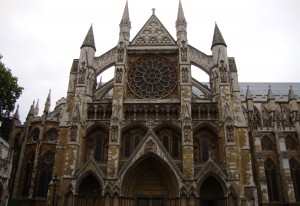
Westminster Abbey
Yesterday, I stood on Charles Darwin’s grave. And no, it was not in a cemetery or science sanctuary, it was in a church. Over 3,000 people are buried at Westminster Abbey. While it is mainly dominated by various royal figures, there are several burials and memorials for literary figures, scientists, and even an unknown soldier. But by far the most shocking person buried there is Charles Darwin. Despite the fact that in many ways his work refutes the teachings of the church, he is still honored there as an important historical figure. This illustrates the importance of English history to the English, to the point where they would rather honor a historical figure who they disgraced with than have his part of history lost.
As an English major, there was also another part of the church I particularly liked: poet’s corner. There I saw stones for many writers including D. H. Lawrence, Lewis Carroll, and Dylan Thomas. However, I was disappointed to realize that not everyone who had a stone on the ground was really buried there. I later learned that these stones served mainly as memorials to recognize these artists’ efforts. One the bright side, I did stand on Charles Dickens, who is actually buried in the church next to Rudyard Kipling.
All these sanctuaries, memorials, and graves, some with carving or detailed sculptures of the deceased present set me thinking about death rituals. The more we looked at these secularized burial spots , the more they began to resemble the Egyptian burial traditions. My knowledge of their practices is limited, but to my understand the Egyptians bury their dead in elaborate tombs with gold and riches to prepare them for the afterlife. And I looked at the extravagant sculpture of Queen Elizabeth lying about her body I began to wonder what the purpose of this whole thing was. Who was really being honored here? Queen Elizabeth? The artist? The patron or surviving family members? Or even the church itself?
And amongst these thoughts, as I walked the tours, the announcement came on for a moment of prayer, it was 11:00. And out of these thoughts of vain royalty, religious celebrations, or tourist attractions, I was reminded that we were in a place of worship, a house of God. And these people were lying here to be with God and to be remembered. These ornate carving and statues were not meant to honor the person, to prepare them for the afterlife, or even to make Westminster Abbey the tourist attraction that it is today; they were made to honor England’s history. Everyday people visit Westminster Abbey and they worship this country’s history.
To view a slideshow of photos from my time at Westminster Abbey, The National Gallery, and the South Bank please click here.
Tags: Churches and Cathedrals · Megan
August 30th, 2009 · 1 Comment
Again I have the problem of figuring out what I want to write about. Because there has been so much going on I think this entry will be a more broad entry about what I have enjoyed seeing and doing these past few days.
On the day we went to Westminster Abbey, I forgot my camera. This type of incident leads me to believe that I am aging? Anyways I was very excited to know that we were going to have a guided tour through the Abbey. It was more than I could have imagined. I never knew it was a tomb to so many heroic and talented people. It took me a few minutes to get over the fact that every step I took my foot landed strategically on top of someones eroding body, but I finally got used to it. It was almost a dream to me to see the tomb of Queen Elizabeth I. I have developed somewhat of an obsession with her over the past year and now that I am here, and have the opportunity to see where she ruled i am even more interested.
After Westminster, Amanda and I went to the British museum. The blog concerning that, and a few other museums will be posted in due time.
I also wanted to blog about Stonehenge and Bath. Our trip to Stonehenge was quite quick however, it was truly fabulous to see it in person. I have to admit, the structure does amount to the size seen in pictures. It really is a magnificent mystery.
On this trip I believe a fell in love with the city of Bath. The architecture and the history is fascinating, and the people are so interesting. Walking through the Roman Baths really allowed for me to imagine Londonium and the early Romans who lived within the country.
We ate lunch in a cute cafe, and I had the yummiest jacket potato! I am obsessed, I will be cooing them in Norwich for sure.
Myself, Chelsea, Sarah and Allie went to the Jane Austin Center. It was so much fun. My mom has been obsessed withe BBC version of Pride and Prejudice forever, and my siblings and I have all had our turns watching alongside her. This center made those characters and the Jane Austin come to life. Her history and her writing was very well depicted through the small but quaint little town house.
I am so glad we have the opportunity to explore outside of the city. I am also thankful that we have readings and other information that prepare us, or rather inform us about what we will see. I love the history in this country, and the more and more we explore, the more I appreciate everything this country has come to be.


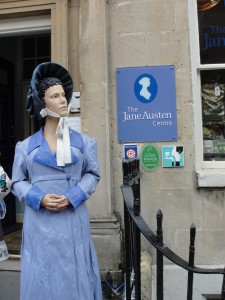
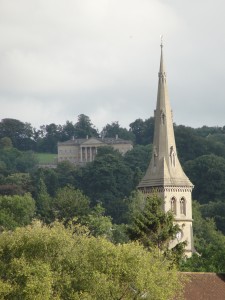
Tags: Patsy

















